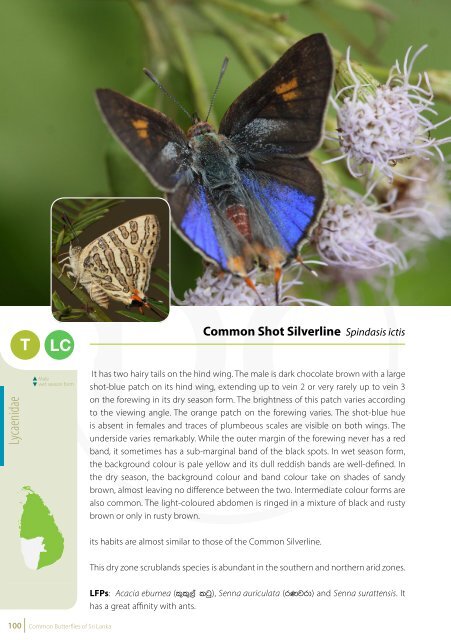Common Butterflies of Sri Lanka
Common Butterflies of Sri Lanka
Common Butterflies of Sri Lanka
You also want an ePaper? Increase the reach of your titles
YUMPU automatically turns print PDFs into web optimized ePapers that Google loves.
T<br />
LC<br />
<strong>Common</strong> Shot Silverline Spindasis ictis<br />
Peacock Royal Tajuria cippus<br />
S<br />
LC<br />
Lycaenidae<br />
Male<br />
wet season form<br />
It has two hairy tails on the hind wing. The male is dark chocolate brown with a large<br />
shot-blue patch on its hind wing, extending up to vein 2 or very rarely up to vein 3<br />
on the forewing in its dry season form. The brightness <strong>of</strong> this patch varies according<br />
to the viewing angle. The orange patch on the forewing varies. The shot-blue hue<br />
is absent in females and traces <strong>of</strong> plumbeous scales are visible on both wings. The<br />
underside varies remarkably. While the outer margin <strong>of</strong> the forewing never has a red<br />
band, it sometimes has a sub-marginal band <strong>of</strong> the black spots. In wet season form,<br />
the background colour is pale yellow and its dull reddish bands are well-defined. In<br />
the dry season, the background colour and band colour take on shades <strong>of</strong> sandy<br />
brown, almost leaving no difference between the two. Intermediate colour forms are<br />
also common. The light-coloured abdomen is ringed in a mixture <strong>of</strong> black and rusty<br />
brown or only in rusty brown.<br />
its habits are almost similar to those <strong>of</strong> the <strong>Common</strong> Silverline.<br />
This dry zone scrublands species is abundant in the southern and northern arid zones.<br />
This is the only species <strong>of</strong> Royal with black eyes. The male has a shot-blue upper<br />
surface with a broad black apical band on the forewing. This black band extends along<br />
the outer and upper margin. The exterior margin <strong>of</strong> the blue patch on the forewing<br />
is irregular. The upper side <strong>of</strong> the female takes on a lighter shade <strong>of</strong> blue with a slight<br />
increase in brightness towards the forewing base. The exterior margin <strong>of</strong> its blue<br />
patch is regular. The blue on its hind wing does not reach the outer margin, leaving<br />
a black patch in between. It has a distal row <strong>of</strong> short, almost parallel, black lines. The<br />
underside looks similar in both sexes and is pure white with two black spots capped<br />
in orange near the tails. The light blue iridescence between these spots varies. Its<br />
distal band <strong>of</strong> black streaks is more prominent on the hind wing than on the forewing.<br />
The Peacock Royal readily comes to herbaceous flowers in open vegetation, but<br />
restricts itself to small trees in wooded areas. It usually selects high positions to bask.<br />
This butterfly can be found in any habitat where its larval food plants are available,<br />
except in dense forest areas. It is low in numbers in the hill country.<br />
Male<br />
Lycaenidae<br />
LFPs: Acacia eburnea (l=l=,a lgq), Senna auriculata (rKjrd) and Senna surattensis. It<br />
has a great affinity with ants.<br />
LFPs: Various Loranthaceae plants including Dendrophthoe ligulata, Taxilus cuneatus<br />
and Dendrophthoe falcata.<br />
100 <strong>Common</strong> <strong>Butterflies</strong> <strong>of</strong> <strong>Sri</strong> <strong>Lanka</strong><br />
<strong>Common</strong> <strong>Butterflies</strong> <strong>of</strong> <strong>Sri</strong> <strong>Lanka</strong> 101















